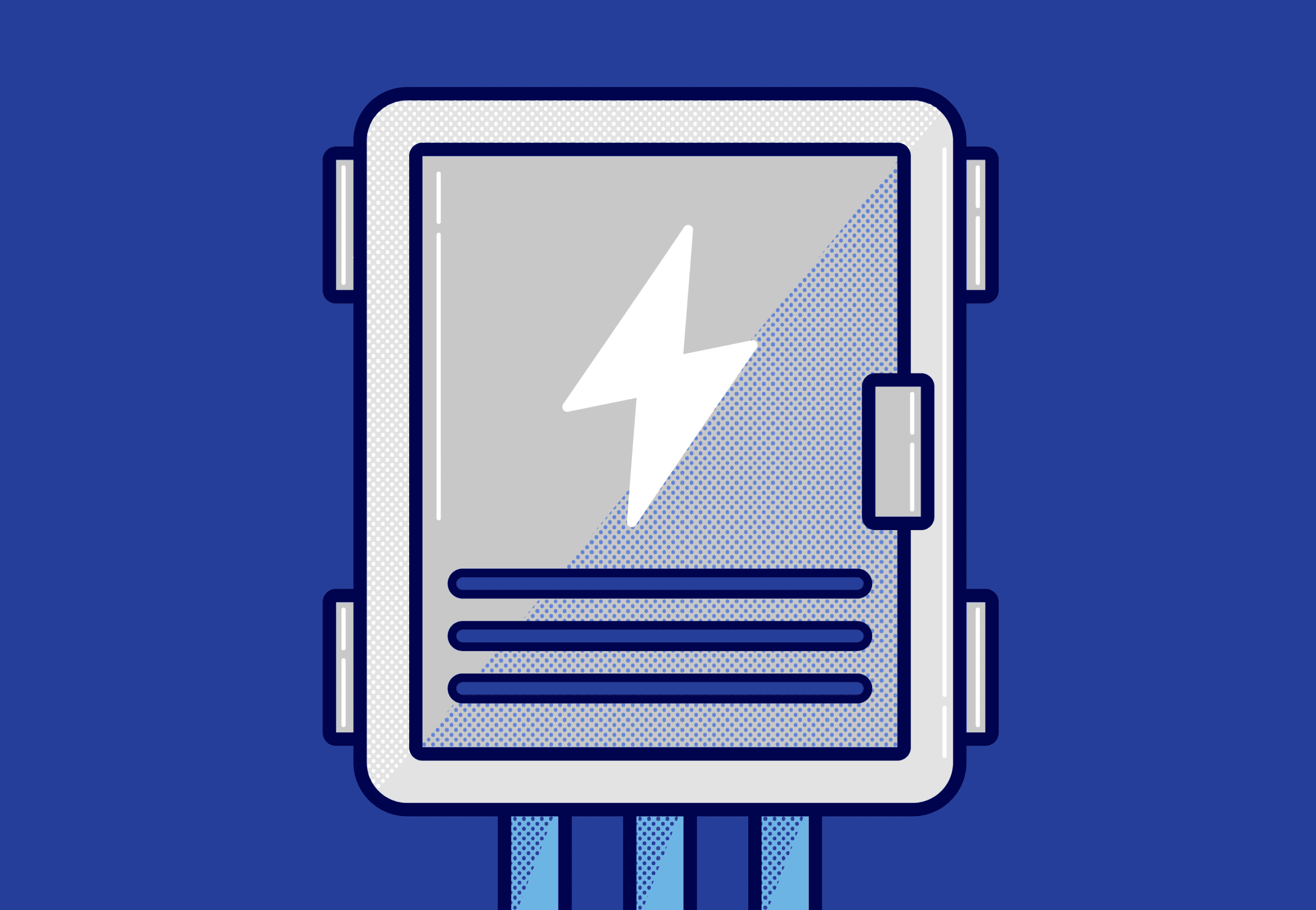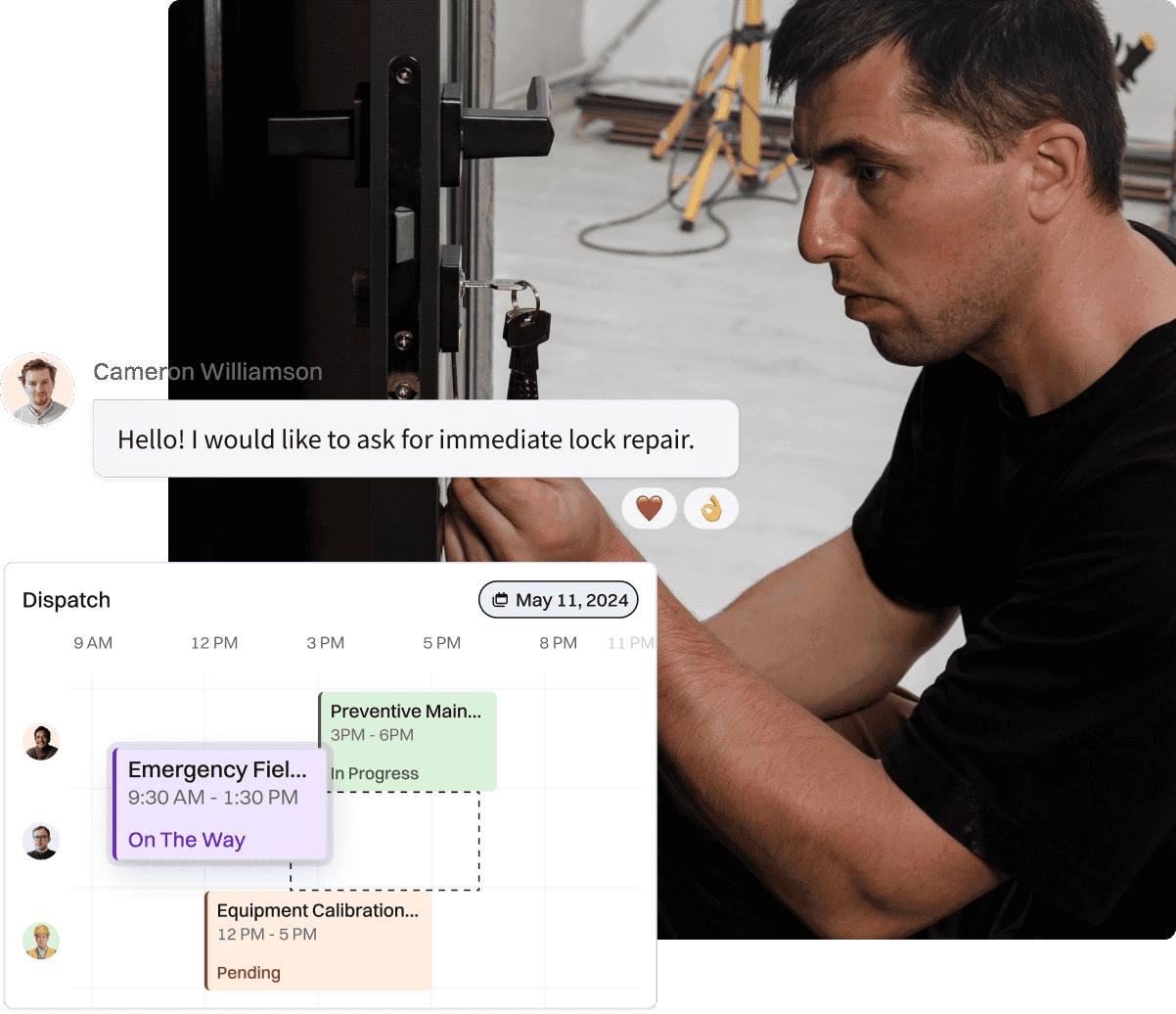Understanding Electrician Job Responsibilities: Key Duties Explained
Explore essential electrician job responsibilities and understand their key duties. Plus, learn how FieldPulse helps you track, train, and scale your team.
Apr 9, 2025

Hiring electricians? Knowing what to expect at each stage of their career, from helper to master, can help you build a skilled, safety-focused team.
In this blog, we’ll break down electrician responsibilities at each career stage—first 3 years, 5 years, and beyond—and explore key differences between residential and commercial electricians and how leveraging an electrician service software like FieldPulse can help you track performance, identify skill gaps, and optimize your team’s growth.
Understanding Electrician Job Descriptions
Each electrician job description evolves as technicians gain experience. Responsibilities expand from support roles to managing complex electrical installations and ensuring code compliance. Understanding how electrician roles progress helps ensure proper placement and effective workforce planning.
Most electricians start their career after earning a high school diploma or equivalent, often applying through online job boards or connecting with electrical contractors. Their journey typically begins with an apprenticeship program and progresses through increasing responsibility and technical specialization. A solid electrician job description provides guidance on what’s expected at each stage.
From interpreting technical diagrams to managing electrical systems in dynamic environments, electricians work across all facets of infrastructure and development. On jobs, helpers and apprentices begin learning the tools and routines of daily electrical work that form the basis of long-term success.
A well-defined electrician job description template helps clarify expectations, required qualifications, and training. These job descriptions must also reflect evolving safety guidelines and updates to the national electrical code.
Electricians work with a wide range of electrical components and technical diagrams that require accuracy and regulatory knowledge. Maintaining clear electrician job descriptions not only aligns expectations but also supports compliance with updated code standards.
Electrician Roles and Responsibilities by Career Stage
Electrician Helper Responsibilities
Electrician helpers are usually new to the trade and perform foundational electrical work. Their role focuses on supporting tasks and gaining exposure to basic electrical systems and tools.
- Set up job sites and organize tools and materials
- Transport electrical equipment, fixtures, and other components
- Assist with installing conduit and pulling electrical wiring
- Hold or position equipment during installation
- Use basic electrical tools like power and hand tools, and wire strippers
- Support maintenance work and preventive maintenance routines
- Follow safety protocols and local building regulations
- Assist with simple lighting systems and troubleshoot electrical issues
- Learn how electricians work with technical diagrams and safety regulations in various environments
As helpers become more comfortable with the basics of electrical systems and safety protocols, they gain critical exposure to the tools and components they’ll use throughout their careers. This includes identifying other components and observing how electricians maintain safe practices on the job.
Apprentice Electrician Responsibilities (0–3 Years)
Apprentices receive structured on-the-job training through certified programs. They gradually take on more technical tasks while being closely supervised. Their responsibilities include:
- Learn to interpret diagrams and wiring blueprints
- Perform basic electrical installations in residential and commercial buildings
- Assist with electrical circuits, lighting systems, and power systems
- Use diagnostic equipment and testing devices to assess system functionality
- Begin to repair electrical wiring and troubleshoot electrical problems
- Understand the National Electrical Code and local electrical codes
- Practice identifying wiring and ensuring safety compliance
- Assist with tasks electricians are expected to complete such as inspecting electrical devices and maintaining proper documentation
- Develop skills in diagnosing issues and managing minor repairs
- Gain exposure to electrical systems used across residential and commercial sectors
This stage helps define how electricians work with real-world systems and builds confidence in their understanding of the national electrical code and safety practices. It also introduces them to other electrical components commonly found in modern installations.
Journeyman Electrician Responsibilities (3–7 Years)
Once an apprentice completes their training, they can become a journeyman electrician. This stage usually occurs around the five-year mark, but exact requirements vary by state. Journeyman electricians can work independently, perform system repairs, and supervise apprentices. They are responsible for ensuring quality and adherence to standards.
- Repair electrical systems and troubleshoot complex electrical issues
- Maintain electrical equipment, devices, and appliances
- Install and inspect electrical systems in commercial facilities
- Perform circuit breaker corrective maintenance and test distribution components
- Use testing equipment and follow detailed job descriptions
- Supervise and ensure job site compliance and safety
- Assist in diagnosing electrical issues and resolving electrical malfunctions
- Collaborate with teams to repair and install control systems and lighting systems
- Follow national electrical code updates and apply knowledge to electrical wiring layouts
Journeymen sharpen their ability to independently install, maintain, and troubleshoot a wide range of electrical systems, ensuring both efficiency and safety on every job. Their work directly supports safe and efficient job completion. They also develop the ability to identify and handle other electrical components with increased confidence.
Master Electrician Responsibilities (7–10+ Years)
Master electricians typically manage projects and teams. Their job combines field knowledge with leadership responsibilities and administrative tasks electricians have.
- Design advanced electrical systems and control systems
- Manage construction site teams and training programs
- Conduct inspections to ensure safety and distribution components are up to code
- Oversee energy efficiency initiatives and system performance
- Implement safety regulations and mentor other electricians
- Handle customer service responsibilities electricians must manage on-site
- Provide guidance on troubleshooting electrical issues and resolving technical challenges
- Ensure electricians maintain tools, documentation, and safety compliance across all job sites
- Lead complex electrical wiring upgrades and guide teams on proper safety procedures.
At this level, electricians work at the intersection of leadership and technical depth, managing large-scale electrical systems and mentoring younger technicians in safety procedures, national electrical code requirements, and job-specific responsibilities. They play a key role in mentoring newer team members, sharing advanced knowledge of system diagnostics, high-voltage components, and safe maintenance practices.
Training and Certification
Throughout their careers, electricians must complete ongoing specialized training to maintain certifications and licenses.
- Fulfill requirements outlined in electrician job description template standards
- Stay current with updates to the National Electrical Code and evolving safety standards
- Gain experience with other systems, including HVAC and air conditioning
- Participate in training programs that emphasize diagnostic accuracy and proper functioning
- Learn best practices for identifying safety hazards and handling other electrical components
- Continue learning about electrical wiring methods, circuit breakers, and advanced diagnostic tools
Training prepares electricians to confidently navigate technical diagrams, electrical equipment, and control systems in increasingly complex jobs. This phase solidifies their understanding of core systems while developing expertise with other electrical components and newer technologies.
Tools and Equipment Electricians Use
To complete jobs safely and efficiently, electricians rely on a variety of tools and technology.
- Electrical tools: wire strippers, power tools, testing devices
- Diagnostic and testing equipment for identifying electrical malfunctions
- Tools for electrical installations and repairing electrical systems
- Use of insulated cables and color coded wiring in high-risk environments
- Hands-on experience with control systems, electrical circuits, and electrical devices
- Follow safety procedures while working with electrical equipment and components
These tools are essential for electricians to work accurately and efficiently, especially as they progress into more complex electrician job responsibilities. Proper training in safety procedures helps reduce risk during installation and troubleshooting tasks.
Electrical Work in Residential vs. Commercial Environments
Residential Work
Residential electricians typically focus on smaller-scale, low-voltage systems within private homes, townhouses, or apartment buildings. Their responsibilities often include installing and upgrading electrical wiring, lighting systems, circuit breakers, outlets, and appliances such as ceiling fans or HVAC controls. These projects may also involve integrating smart home technologies, EV chargers, and backup generators.
Because they often interact directly with homeowners, customer service is a key part of the residential electrician’s role. Communication, scheduling flexibility, and cleanliness on-site are highly valued in this segment of the industry.
Need more information on pricing electrical work? Our Residential Electrical Pricing Guide breaks down how to estimate residential electrical jobs, covering labor, materials, overhead, and profit margins. Accurate pricing and transparent estimates help build customer trust and ensure consistent profitability.
Commercial Work
Commercial electricians manage complex, high-voltage systems across large infrastructure projects. This includes office buildings, retail stores, hospitals, schools, warehouses, and factories. Typical tasks include installing or maintaining three-phase electrical systems, backup generators, control systems, energy-efficient lighting, and data cabling for networking.
Because commercial environments often have complex layouts and stricter timelines, electricians in this field must be skilled in reading technical blueprints, adhering to project specifications, and complying with more advanced safety protocols. They also need to be familiar with different tools and materials used for industrial applications.
Commercial electricians frequently work alongside general contractors, project managers, or engineers, making collaboration and planning skills crucial. They may also need to be available for work during off-hours to accommodate business operations.
Both types of work involve a variety of skills, including diagnosing electrical issues, ensuring system reliability, and applying appropriate codes and safety protocols. Job descriptions should clearly reflect the differing scopes, tools, and code requirements of residential and commercial work. Mastering technical diagrams, electrical wiring protocols, and safety procedures is essential to long-term success.
FieldPulse: Supporting Electrical Business Operations
Leveraging FieldPulse for Electrician Hiring and Performance Tracking
Hiring, training, and supporting the right electrical talent is only the first step. To ensure ongoing success, it’s important to track performance, support continued growth, and streamline operations. Using a field service management tool like FieldPulse, businesses can increase efficiency, enhance job execution, and provide valuable insights that help their teams develop and perform at their best.
Monitor Productivity and Efficiency
FieldPulse provides tools for monitoring productivity and efficiency using performance metrics tailored to different electrician roles. By assessing each electrician's efficiency across tasks, you can identify high performers and areas that need improvement. Streamlining productivity tracking helps ensure your team is consistently meeting expectations and improving over time.
Identify Skill Gaps and Provide Targeted Training
Reviewing historical job performance through FieldPulse allows you to pinpoint skill gaps and provide tailored training. By analyzing completed jobs and identifying recurring challenges, you can offer targeted training sessions to enhance your electricians' skills and boost overall performance.
Track Certifications and Ensure Compliance
FieldPulse simplifies tracking certifications for apprentices, journeymen, and master electricians, ensuring ongoing compliance with industry standards. With a centralized system, you can monitor certification statuses, set renewal reminders, and ensure all team members meet necessary regulatory requirements.
Optimize Training Processes
FieldPulse helps you optimize your training processes based on the most common jobs your business handles. By identifying patterns in completed work, you can tailor training to ensure technicians are equipped with the skills they need to excel in their roles and meet client expectations.
Automate Performance Reviews and Feedback
FieldPulse supports automated performance reviews and feedback loops, encouraging continuous improvement and growth. By scheduling regular evaluations and collecting feedback from customers and supervisors, you can provide actionable insights that help electricians progress through their careers.
Make Data-Driven Decisions
FieldPulse’s dashboards and reporting tools empower you to make data-driven decisions for hiring, training, and promoting electricians. By analyzing performance data and identifying trends, you can make strategic decisions that enhance your business’s efficiency and profitability.
Conclusion
Many electricians follow a defined path from helper to master, progressing through increasingly complex responsibilities. Whether you're onboarding a new hire or preparing an experienced journeyman for promotion, understanding the full range of electrician responsibilities is key to workforce success.
FieldPulse supports that journey with digital tools for performance tracking, training optimization, and compliance monitoring.
Want to see how FieldPulse helps electrical contractors manage teams and projects more efficiently?
How much will you grow?
See how FieldPulse can take your business further.


